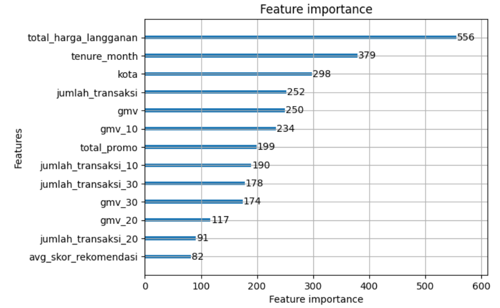Main Article Content
Abstract
Increasingly tight competition in the business world causes every business sector to try to utilize relevant technology to maintain its market share. The success of a company is often measured by how strong the customer network they have. Loss of customers (customer churn) can cause a significant decrease in revenue and can even threaten the existence of the company itself. Therefore, predictive modeling and projection of customer churn is needed as a customer retention effort. This research involves the LightGBM classification algorithm for customer churn prediction and utilizes survival analysis for future projections. The results of the research can be used to prevent customer churn at companies, especially PT Kasir Pintar Internasional. LightGBM classification performance as measured by model evaluation reaches Accuracy, Precision, Recall, and F1-score values of 0.964, 0.971, 0.990, and 0.980 respectively. The LightGBM classification model also provides information on five important features that influence customer churn. Companies can use these five important features as material for designing customer retention strategies. Apart from that, the Cox Proportional Hazard survival model has a C-index evaluation value of 0.83, which means it is quite capable of projecting customer survival. The survival model also shows that currently non-churn customers have an average survival expectation of 15 months.
Keywords
Article Details

This work is licensed under a Creative Commons Attribution-NonCommercial 4.0 International License.
References
- A. Tahar, P. B. Setiadi, dan S. Rahayu, “Strategi Pengembangan Sumber Daya Manusia dalam Menghadapi Era Revolusi Industri 4.0 Menuju Era Society 5.0,” J. Pendidik. Tambusai, vol. 6, no. 2, hal. 12380–12394, 2022.
- U. Alrasyid, “Infografis Startup Indonesia Terbesar Ke-6 Dunia,” iNews.id. Diakses: 29 September 2023. [Daring]. Tersedia pada: https://www.inews.id/multimedia/infografis/infografis-startup-indonesia-terbesar-ke-6-dunia
- F. F. Maulyan, D. Yuniati Drajat, R. Y. Angliawati, dan D. Sandini, “Pengaruh Service Excellent Terhadap Citra Perusahaan Dan Loyalitas Pelanggan: Theoretical Review,” J. Sains Manaj., vol. 4, no. 1, hal. 8–17, 2022, doi: 10.51977/jsm.v4i1.660.
- L. B. Asmaradana dan M. D. Satyawan, “Analisis Financial Distress dengan Model Altman, Grover, Springate, Zmijewski, dan Ohlson pada Perusahaan Subsektor Jasa Konsumen yang terdaftar di BEI,” J. Ilmu Komputer, Ekon. dan Manaj., vol. 2, no. 1, hal. 1325–1341, 2022.
- H. N. Irmanda, R. Astriratma, dan S. Afrizal, “Perbandingan Metode Jaringan Syaraf Tiruan Dan Pohon Keputusan Untuk Prediksi Churn,” JSI J. Sist. Inf., vol. 11, no. 2, hal. 1817–1825, 2019, doi: 10.36706/jsi.v11i2.9286.
- I. Ullah, B. Raza, A. K. Malik, M. Imran, S. U. Islam, dan S. W. Kim, “A Churn Prediction Model Using Random Forest: Analysis of Machine Learning Techniques for Churn Prediction and Factor Identification in Telecom Sector,” IEEE Access, vol. 7, hal. 60134–60149, 2019, doi: 10.1109/ACCESS.2019.2914999.
- J. Pamina dkk., “An effective classifier for predicting churn in telecommunication,” J. Adv. Res. Dyn. Control Syst., vol. 11, no. 1 Special Issue, hal. 221–229, 2019.
- K. Arai, I. Fujikawa, Y. Nakagawa, R. Momozaki, dan S. Ogawa, “Churn Customer Estimation Method based on LightGBM for Improving Sales,” Int. J. Adv. Comput. Sci. Appl., vol. 14, no. 2, hal. 119–125, 2023, doi: 10.14569/IJACSA.2023.0140215.
- T. M. Fahrudin dan I. Z. A. Illah, “SkinMate: Mobile-Based Application for Detecting Multi-Class Skin Diseases Classification Using Pre-Trained MobileNetV2 on CNN Architecture,” Proceeding - IEEE 9th Inf. Technol. Int. Semin. ITIS 2023, 2023, doi: 10.1109/ITIS59651.2023.10420370.
- T. Informasi, V. No, dan M. A. D. Yuda, “Transformasi Data Solarman Untuk Pengungkapan Informasi dan Pola PLTS dengan Metode Semi-Supervised Learning,” vol. 1, no. 2, hal. 100–110.
- C. Zai, “Implementasi Data Mining Sebagai Pengolahan Data,” vol. 2, no. 3, hal. 1–12, 2022.
- M. N. Faiz, O. Somantri, dan A. W. Muhammad, “Rekayasa Fitur Berbasis Machine Learning untuk Mendeteksi Serangan DDoS,” vol. 11, no. 3, hal. 176–182, 2022.
- Btd, “Simplifying Complexity: Feature Selection with Recursive Feature Elimination,” medium. Diakses: 2 Februari 2024. [Daring]. Tersedia pada: https://readmedium.com/en/https:/baotramduong.medium.com/machine-learning-feature-selection-recursive-feature-elimination-88750767c05f
- E. Y. Puspaningrum, Y. V. Via, C. Nisa, H. Maulana, dan W. S. J. Saputra, “Oversampled-Based Approach to Overcome Imbalance Data in the Classification of Apple Leaf Disease with SMOTE,” Rom. J. Ofapplied Sci. Technol., vol. 16, no. 3, hal. 112–117, 2023.
- F. I. Kurniadi dan P. D. Larasati, “Light Gradient Boosting Machine untuk Deteksi Penyakit Stroke,” J. SISKOM-KB (Sistem Komput. dan Kecerdasan Buatan), vol. 6, no. 1, hal. 67–72, 2022, doi: 10.47970/siskom-kb.v6i1.328.
- D. A. I. Maruddani, Tarno, A. Hoyyi, R. Rahmawati, dan Y. Wilandari, Survival analysis. UNDIP Press Semarang, 2021. doi: 10.1007/978-1-4614-4322-3_1.
- J. Soedirman, “Analisis Bibliometrik Penggunaan Analisis Survival Model Regresi Cox,” J. Ris. Akunt. Soedirman, vol. 2, no. 2, hal. 111–120, 2023, doi: 10.32424/1.jras.2023.2.2.10806.
- P. Purwono, A. Wirasto, dan K. Nisa, “Comparison of Machine Learning Algorithms for Classification of Drug Groups,” Sisfotenika, vol. 11, no. 2, hal. 196, 2021, doi: 10.30700/jst.v11i2.1134.
- A. T. Damaliana, T. Trimono, and D. A. Prasetya, “Ensemble Tree untuk Memprediksi Level Resiko Maternal Mortality di Bangladesh,” PROSIDING SEMINAR NASIONAL SAINS DATA, vol. 2, no. 1, pp. 24–29, Nov. 2022, Accessed: Jun. 08, 2024.
- D. A. Prawinata, A. D. R. Rahajoe, dan I. G. S. M. Diyasa, “Analisis Sentimen Kendaraan Listrik Pada Twitter Menggunakan Metode Long Short Term Memory,” SABER J. Tek. Inform. Sains dan Ilmu Komun., vol. 2, no. 1, hal. 300–313, 2024, [Daring]. Tersedia pada: https://jurnal.stikes-ibnusina.ac.id/index.php/SABER/article/view/857

